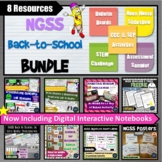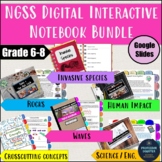NGSS Science and Engineering Practices Stations Digital Interactive Notebook
- PDF
- Google Apps™

What educators are saying
Also included in
- This NGSS Next Generation Science Standards for Middle School Science Mega Bundle has ALL of my NGSS labs, lessons, bulletin boards, posters, activities, assessments, projects, and other resources combined into one product (most of which have been or are being edited for distance learning) ! It offePrice $349.99Original Price $521.25Save $171.26
- Jumpstart your school year with this bundle of NGSS-aligned Back to School resources (and 3 freebies) which are sure to engage and challenge your students' thinking and impress parents and colleagues during the first few weeks of school! These middle school activities have been updated to include diPrice $18.00Original Price $24.00Save $6.00
- NEW! This slow GROWING bundle contains 6 of my NGSS aligned digital interactive notebooks in Google Slides for middle school which include Human Impact, Rocks and the Rock Cycle, Crosscutting Concepts, Science and Engineering Practices, an Invasive Species activity, and a Waves Stations investigatioPrice $26.00Original Price $32.00Save $6.00
Description
If you’re looking for a rich, quality NGSS lab station activity with worksheets and a digital notebook option to introduce and/or reinforce the Science and Engineering Practices SEPs to middle or high school students whether during remote/distance learning or while in person, then this is the perfect resource for you! Students rotate through 8 stations/tabs to become familiarized with the SEPs in which they engage in the practice to start to learn how it is used to build scientific knowledge.
****NEWLY ADDED! A Google Slides digital interactive notebook version of this product is included with this purchase (link to the notebook is located in the PDF)!!!! It's 2 products for the price of one! This product has also been updated to include all 8 practices and can even be downloaded as a PowerPoint presentation! Check out the video previewhere!
Check out other science resources in my store here!
Real world scenarios are included at each station to make them explicit and meaningful. Some stations require short student experiments while others involve asking questions, using data to make observations, analyzing data, and drawing conclusions.
----->Click here for the elementary grades 3-5 version! NGSS Science and Engineering Practices Activity for Grades 3-5
----->Click here for a Crosscutting Concepts Activity with digital interactive notebook: Crosscutting Concepts Stations Activity.
This simple-materials resource (see materials list below for each station, no materials are required for the interactive notebook except for a computer and internet access) is crucial in exposing students to these practices at the beginning of the year so that they may recognize them throughout their learning experiences to develop their ideas, support them with evidence, reflect, and ultimately deepen their understanding of the natural world. If you’re new to the NGSS, this activity will even help YOU understand them better! Options for extension activities and trendy labels to print and display the SEPs on a bulletin board are also included! No prior knowledge of the SEPs or of the topics of the stations is required although it may be helpful! Download the preview and check it out! !
Students should not be assessed on their ability to define the science and engineering practices in isolation. Rather, students should start to recognize which practice they are using to understand the disciplinary core ideas while making see connections to the crosscutting concepts. The more comfortable students get with engaging in these practices, the more they will be able to build scientific knowledge. This is the value of exposing students to the SEPs at the beginning of the school year. The recommended time is about 8 minutes per station (for interactive notebook it is about 2-3 tabs per class period) and then time to review the stations as a class. Students could also use leftover time at a station to go back and finish another! It generally takes two-three class periods to complete the activity and review. The materials for each station are simple, easy-to-gather and listed below.
Stations Overview:
NOTE: The interactive notebook version of this activity includes all needed materials/resources in the slides!
1. Asking Questions and Defining Problems: Students squeeze a plastic water bottle with water and a ketchup packet inside (Cartesian Diver) to ask questions about the phenomenon of the packet rising and sinking. More info here: Cartesian Diver Materials: plastic water bottle filled with water and an unopened, fast food ketchup packet (interactive notebook doe s not require this, it provides a video link to a demo)
2. Constructing Explanations and Designing Solutions: Students look at a data table of increased Lyme disease reports over the last 20 years to construct an explanation of why and to develop a solution (idea or tool) using simple materials to attempt to solve the problem. Materials: simple classroom materials such as paperclips, construction paper, toothpicks, etc.
3. Planning and Carrying Out Investigations: Students plan and conduct an experiment to prove that two objects of varying masses fall at the same rate. Materials: balance, two common objects of varying masses (tennis ball/ping pong ball, marble/foil ball, book/pencil)
4. Developing and Using Models: Students read through examples of models and answer questions. Materials: globe or other 3D replica as an example of one kind of model to display, images (provided)
5. Analyzing and Interpreting Data: Students read through an experiment conducted on sizes of Koi and the sizes of their habitats, analyze the data, and construct a graph of the data. Materials: rulers, graph paper (not necessary), sample graph that can be used as differentiation (provided)
6. Engaging in Argument from Evidence: Students read information about the corpse flower and critique two students’ arguments. Materials: Image of Corpse Flower (provided)
7. Using Mathematics and Computational Thinking: Students read through the results of an experiment conducted to see what happens to the rate of melting snow when a coat is put over something cold such as a snowman. They name mathematical tools used and analyze the data to observe patterns and draw conclusions. Materials: laboratory tools such as a calculator, graduated cylinder, beaker, etc.
8. Obtaining, Evaluating, and Communicating Information: Students read about the importance of reading, understanding, and critiquing science information and watch a three minute YouTube video on reliable sources to answer questions. Materials: Computer/internet access to view a video:
Included in this resource:
- Student lab sheets
- Link to Interactive Notebook file
- “For the Teacher” Section with tips
- Trendy Labels of SEPs to print and display
- Simple Materials List for each station
- Ideas for Extensions
- Answer Keys
- Philosophy on why introducing the SEPs are necessary
- Links to more info on the SEPs
- Images
If you’re looking for full page copies of all 3 dimensions of the NGSS to use as your objectives, you can find them here: NGSS Objective Board Labels. Making your daily objectives clear without giving away anything is very important! It’s a method that I use in my classroom: Defining Daily Learning Goals
Let’s Connect!
Follow my store at this link to stay up-to-date on my latest NGSS resources! Click here!
Are you on Facebook? Be sure to follow me on Facebook for NGSS FREEBIES, updates on what I’m working on, and of course, science memes! Professor Doubter's Facebook Page
Other Products you may be interested in:
Human Impact Digital Interactive Notebook
First Day of School STEM Activity
First Day of School Welcome Letter
Science Notebook Cover and Organizer
Welcome Back Elements Bulletin Board
Accountable Talk Posters and Stems
Keep Calm Science Bulletin Board
Famous Science Fails Bulletin Board
Looking for NGSS lessons, units, activities, etc.? Check out my store and the links below for more: Store Link.
Assessment Questions & Tasks for MS-PS1
Human Impact Investigation & STEM Project
Synthetic and Natural Resources STEM Project
STEM Challenges For Every Month
First Day of School STEM Name Tag Design
Modeling Analog and Digital Signals
Introduction to Waves Activity
Modeling Reflection of Light Lab
Prevent a Chemical Change With Pennies Lab
Magnetic Fields and Eating Nails For Breakfast Lab
Modeling Particle Motion, State, and Temperature Lab
Physical and Chemical Changes Minilabs
Dry Ice Demonstration on Sublimation
Potential and Kinetic Energy Worksheet
Modeling Compounds and Molecules with Fasteners
Rutherford's Discovery of the Nucleus Lab (FREE)
Maintaining Biodiversity Activity
Modeling Food Chains and Food Webs Affected by the BP Oil Spill
Living Things are Made of Cells Online Investigation
Modeling Cell Organelles with Analogies
Natural Selection Butterfly Lab
Resource Availability in Ecosystems Activity
Gathering Evidence for Photosynthesis Lab
Adaptations and Biomimicry STEM Lab
Erosion and Soil Conservation STEM Project
Scale Model of the Solar System Lab (FREE)
Science Accountable Talk Starters and Stems Posters
Unit Planning Template (With Example)
Buy the bundle and have access to all NGSS resources!
NGSS Physical Science Bundle: Click Here
NGSS Life Science Bundle: Click Here
NGSS Earth Science Bundle: Click Here
NGSS All Resources Bundle: Click Here
Feel free to share my website with colleagues. Each purchase is a license for ONE person to use in a classroom setting per my Terms of Use. Distribution or sharing of any products are in violation of copyright law.
Don't forget to rate my product to earn TPT credits!! CHECK OUT MY NGSS LESSONS IN MY STORE AND BE SURE TO FOLLOW ME TO STAY UP-TO-DATE ON THE LATEST NGSS RESOURCES!!!








